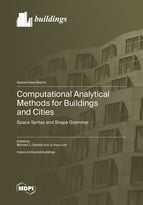Computational Analytical Methods for Buildings and Cities: Space Syntax and Shape Grammar
A special issue of Buildings (ISSN 2075-5309). This special issue belongs to the section "Architectural Design, Urban Science, and Real Estate".
Deadline for manuscript submissions: closed (28 February 2023) | Viewed by 41790
Special Issue Editors
Interests: architecture; design; mathematics; computing
Special Issues, Collections and Topics in MDPI journals
Special Issue Information
Dear Colleagues,
This Special Issue is focussed on advanced research using two of the most famous computational methods developed for buildings and cities: space syntax and shape grammar.
Space syntax is a classic computational approach that uses graph theory mathematics to measure the social, cognitive or experiential properties of a building. Shape grammar is a well-known computational method for identifying and understanding the logic that defines the formal properties of a design or style. In essence, ‘syntactical’ methods are concerned with the spatial or topological configuration of a building and ‘grammatical’ methods with the rules that shape a building’s formal or geometric properties.
For this Special Issue, we are seeking examples of advanced research using these methods—or a combination of them alongside related approaches (isovists analysis or generative and parametric grammars)—to develop new insights into generating and evaluating design, automation, optimisation and interpretation.
Prof. Dr. Michael J. Ostwald
Dr. Ju Hyun Lee
Guest Editors
Manuscript Submission Information
Manuscripts should be submitted online at www.mdpi.com by registering and logging in to this website. Once you are registered, click here to go to the submission form. Manuscripts can be submitted until the deadline. All submissions that pass pre-check are peer-reviewed. Accepted papers will be published continuously in the journal (as soon as accepted) and will be listed together on the special issue website. Research articles, review articles as well as short communications are invited. For planned papers, a title and short abstract (about 100 words) can be sent to the Editorial Office for announcement on this website.
Submitted manuscripts should not have been published previously, nor be under consideration for publication elsewhere (except conference proceedings papers). All manuscripts are thoroughly refereed through a single-blind peer-review process. A guide for authors and other relevant information for submission of manuscripts is available on the Instructions for Authors page. Buildings is an international peer-reviewed open access monthly journal published by MDPI.
Please visit the Instructions for Authors page before submitting a manuscript. The Article Processing Charge (APC) for publication in this open access journal is 2600 CHF (Swiss Francs). Submitted papers should be well formatted and use good English. Authors may use MDPI's English editing service prior to publication or during author revisions.
Keywords
- space syntax
- shape grammar
- isovist analysis
- justified graph analysis
- design automation
- design generation
- procedural modelling, genetic algorithm
- parametric grammars
- spatial and formal analysis in architecture







